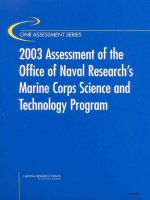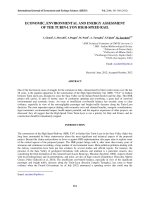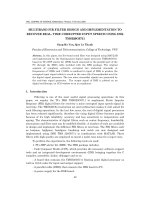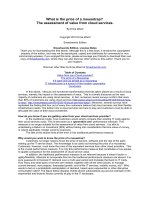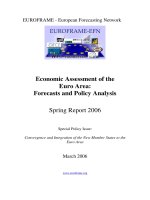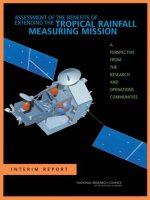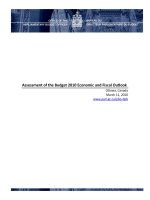Assessment of the Content, Design, and Dissemination of the Real Warriors Campaign pptx
Bạn đang xem bản rút gọn của tài liệu. Xem và tải ngay bản đầy đủ của tài liệu tại đây (559.27 KB, 114 trang )
A JOINT ENDEAVOR OF RAND HEALTH AND THE
RAND NATIONAL DEFENSE RESEARCH INSTITUTE
Center for Military Health Policy Research
For More Information
Visit RAND at www.rand.org
Explore the RAND Center for Military Health Policy Research
View document details
Support RAND
Purchase this document
Browse Reports & Bookstore
Make a charitable contribution
Limited Electronic Distribution Rights
is document and trademark(s) contained herein are protected by law as indicated in a notice appearing
later in this work. is electronic representation of RAND intellectual property is provided for non-
commercial use only. Unauthorized posting of RAND electronic documents to a non-RAND website is
prohibited. RAND electronic documents are protected under copyright law. Permission is required from
RAND to reproduce, or reuse in another form, any of our research documents for commercial use. For
information on reprint and linking permissions, please see RAND Permissions.
Skip all front matter: Jump to Page 16
e RAND Corporation is a nonprot institution that helps improve policy and
decisionmaking through research and analysis.
is electronic document was made available from www.rand.org as a public service
of the RAND Corporation.
CHILDREN AND FAMILIES
EDUCATION AND THE ARTS
ENERGY AND ENVIRONMENT
HEALTH AND HEALTH CARE
INFRASTRUCTURE AND
TRANSPORTATION
INTERNATIONAL AFFAIRS
LAW AND BUSINESS
NATIONAL SECURITY
POPULATION AND AGING
PUBLIC SAFETY
SCIENCE AND TECHNOLOGY
TERRORISM AND
HOMELAND SECURITY
is product is part of the RAND Corporation technical report series. Reports may
include research ndings on a specic topic that is limited in scope; present discussions
of the methodology employed in research; provide literature reviews, survey instru-
ments, modeling exercises, guidelines for practitioners and research professionals, and
supporting documentation; or deliver preliminary ndings. All RAND reports un-
dergo rigorous peer review to ensure that they meet high standards for research quality
and objectivity.
Assessment of the
Content, Design, and
Dissemination of the Real
Warriors Campaign
Joie D. Acosta, Laurie T. Martin, Michael P. Fisher,
Racine Harris, Robin M. Weinick
Prepared for the Office of the Secretary of Defense
Approved for public release; distribution unlimited
A JOINT ENDEAVOR OF RAND HEALTH AND THE
RAND NATIONAL DEFENSE RESEARCH INSTITUTE
Center for Military Health Policy Research
The RAND Corporation is a nonprofit institution that helps improve policy and
decisionmaking through research and analysis. RAND’s publications do not necessarily
reflect the opinions of its research clients and sponsors.
R
®
is a registered trademark.
© Copyright 2012 RAND Corporation
Permission is given to duplicate this document for personal use only, as long as it
is unaltered and complete. Copies may not be duplicated for commercial purposes.
Unauthorized posting of RAND documents to a non-RAND website is prohibited. RAND
documents are protected under copyright law. For information on reprint and linking
permissions, please visit the RAND permissions page (
permissions.html).
Published 2012 by the RAND Corporation
1776 Main Street, P.O. Box 2138, Santa Monica, CA 90407-2138
1200 South Hayes Street, Arlington, VA 22202-5050
4570 Fifth Avenue, Suite 600, Pittsburgh, PA 15213-2665
RAND URL:
To order RAND documents or to obtain additional information, contact
Distribution Services: Telephone: (310) 451-7002;
Fax: (310) 451-6915; Email:
Library of Congress Cataloging-in-Publication Data
Assessment of the content, design, and dissemination of the Real Warriors Campaign / Joie D. Acosta [et al.].
p. cm.
Includes bibliographical references.
ISBN 978-0-8330-6310-6 (pbk. : alk. paper)
1. Soldiers—Mental health services—United States—Evaluation. 2. United States—Armed Forces—Mental
health services—Evaluation. 3. Mass media in health education—United States. I. Acosta, Joie D.
UH629.3.A77 2012
362.2086'970973—dc23
2012011679
The research described in this report was prepared for the Office of the Secretary of
Defense (OSD). The research was conducted jointly by the Center for Military Health
Policy Research, a RAND Health program, and the Forces and Resources Policy Center, a
RAND National Defense Research Institute (NDRI) program. NDRI is a federally funded
research and development center sponsored by OSD, the Joint Staff, the Unified Combatant
Commands, the Navy, the Marine Corps, the defense agencies, and the defense Intelligence
Community under Contract W74V8H-06-C-0002.
iii
Preface
An increasing number of studies and news articles have highlighted concerns about
deployment-related mental health problems among military service personnel. Recog-
nizing that barriers to obtaining mental health care were a critical issue, the Department of
Defense (DoD) has implemented numerous programs designed to address issues related to
mental health and psychological well-being among servicemembers and their families, includ-
ing programs designed to promote resilience and reintegration of servicemembers returning
from combat zones, and to support their families. e Real Warriors Campaign is one such
program.
e purpose of this report is to present ndings based upon an independent assessment
of the content, design, and dissemination of the Real Warriors Campaign. e assessment was
conducted between January and August 2011. Launched in 2009, the Real Warriors Cam-
paign is a large-scale multimedia program designed to promote resilience, facilitate recovery,
and support the reintegration of returning servicemembers, veterans, and their families. e
campaign itself is fairly new; at the time of this report, there was the possibility of changes to
the content or dissemination of the campaign because the contract to manage the campaign
was being re-competed. erefore, the assessment described in this report focuses on identify-
ing which aspects of the campaign adhere to best practices for health communication cam-
paigns and ways the campaign could improve both its content and its dissemination activities.
To conduct the assessment we convened an expert panel, conducted telephone discussions with
organizations that partnered with the campaign, performed a content analysis of the cam-
paign’s website, analyzed communication measures collected by the campaign, and reviewed
relevant documents describing the design and development of the campaign.
e contents of this report will be of particular interest to national policymakers within
the DoD and should also be useful for health policy ocials within the U.S. Department of
Veterans Aairs (VA), as well as policymakers in other sectors who sponsor or manage media
campaigns to support mental health more generally.
is research was sponsored by the Assistant Secretary of Defense for Health Aairs
and the Defense Centers of Excellence for Psychological Health and Traumatic Brain Injury
(DCoE) and conducted jointly by RAND Health’s Center for Military Health Policy Research
and the Forces and Resources Policy Center of the RAND National Defense Research Insti-
tute (NDRI). e Center for Military Health Policy Research taps RAND expertise in both
defense and health policy to conduct research for DoD, the Veterans Health Administration,
and nonprot organizations. NDRI is a federally funded research and development center
sponsored by the Oce of the Secretary of Defense, the Joint Sta, the Unied Combatant
Commands, the Navy, the Marine Corps, the defense agencies, and the defense Intelligence
Community.
iv Assessment of the Content, Design, and Dissemination of the Real Warriors Campaign
For more information on the Center for Military Health Policy Research, see
or contact the director (contact information is pro-
vided on the web page). For more information on the RAND Forces and Resources Policy
Center, see or contact the director (contact
information is provided on the web page).
v
Contents
Preface iii
Figures
vii
Tables
ix
Summary
xi
Acknowledgments
xvii
Abbreviations
xix
CHAPTER ONE
Introduction 1
Purpose of is Report
2
Methods
3
Literature Review
4
Expert Panel
4
Telephone Discussions with RWC Partner Organizations
5
Content Analysis of the RWC Website
5
Analysis of RWC Communication Measures
5
Document Review and Discussions with RWC Sta
6
Organization of is Report
6
CHAPTER TWO
Rationale, Content, Design, and Dissemination of the Real Warriors Campaign 7
Rationale for Developing the Real Warriors Campaign: Servicemembers Face Unique Barriers to
Accessing Care for Mental Health Problems
7
Need for a Media Campaign to Encourage Servicemembers to Seek Care
8
eoretical Basis of the Real Warriors Campaign
9
Design and Content of the Campaign: Target Populations, Campaign Goals, Messages, and
Materials
10
Target Populations
11
Campaign Goals
11
Core Messages
12
Campaign Activities and Materials
12
Dissemination of the Real Warriors Campaign
12
Website
12
Partner Organizations
13
Conferences and Other Outreach Eorts
14
vi Assessment of the Content, Design, and Dissemination of the Real Warriors Campaign
CHAPTER THREE
Results of RAND’s Assessment of the Real Warriors Campaign 15
Campaign Design: Goals, Target Populations, and Messages of the Campaign
15
Campaign Goals Are Clear, but ey Are Not Clearly Stated in the Real Warriors Campaign
Materials
15
Health Professionals Are a Less Relevant Target Population
16
ere May Be Important Dierences Within Target Audiences
17
Core Messages Are Relevant and Right for the Campaign
18
Campaign Content
19
Video Proles Are the Most Compelling Content
19
e Breadth of the Content Dilutes the Campaign’s Key Messages
20
e Depth of Content Is Uneven Across Goals and Target Populations
20
Updated Content Is Essential
21
Campaign Dissemination
22
e Real Warriors Campaign Website Is Useful, but Navigation Is a Challenge for Some
22
Social Media Channels Are Not Fully Utilized
23
Not All Partners Are Actively Engaged
23
Partner Organizations Want More Interaction with the Campaign
24
Partner Organizations Want More Interaction with Other Partners
25
Conferences and Events Are Useful for Dissemination, but Could Be Improved
25
Research and Ongoing Monitoring
26
Research Should Continue to Be Utilized to Build Campaign Goals and Messages
26
Communication Metrics Are Not Fully Leveraged
27
Mechanisms to Gather Regular Feedback Are Lacking, and More Usability Testing Is
Needed
27
Limitations of Our Assessment
28
CHAPTER FOUR
Recommendations to Improve Future Design and Dissemination of the Real Warriors
Campaign
31
Recommendations to Improve Design and Content of the Real Warriors Campaign
31
Recommendations to Improve the Dissemination of the Real Warriors Campaign
32
Recommendations to Improve the Real Warriors Campaign’s Use of Research and Evaluation
34
Conclusions
36
APPENDIXES
A. Summary Description of Appendixes B through F 37
B.
Literature Review Methods and Findings 39
C. Expert Panel Methods and Findings
47
D. Discussions with Real Warriors Campaign Partner Organizations
61
E. Content Analysis Methods and Findings
71
F. Methods and Findings from RAND Analysis of Real Warriors Campaign
Communication Metrics
77
References
89
vii
Figures
1.1. Logic Model for RAND Assessment 3
2.1. Health Belief Model as Applied to the Real Warriors Campaign
9
3.1. Average Number of Page Views by Quarter in 2010
17
F.1. Number of Page Views and Average Time Viewed for Active Duty Section of
the Website
78
F.2. Number of Page Views and Average Time Viewed for National Guard/Reserve
Section of the Website
79
F.3. Number of Page Views and Average Time Viewed for Veterans Section of the
Website
79
F.4. Number of Page Views and Average Time Viewed for Family Section of the Website
80
F.5. Number of Page Views and Average Time Viewed for Health Professionals Section
of the Website
80
F.6.
Number of Page Views and Average Time Viewed for Multimedia Section of
the Website
81
F.7. Internet Referral Sources to RWC Website
82
F.8. Number of Facebook Fans and Fans Added Each Month
82
F.9. Number of Facebook Interactions over Time
83
F.10. Number of Twitter Followers and Followers Added Each Month
83
F.11. Number of RWC Re-Tweets
84
F.12. Number of YouTube Videos Viewed Overall, and per Month
85
F.13. Number of Message Board Members and Active Message Board Members
85
F.14. Message Board Posts over Time
86
F.15. Number of Requests for Materials and Total Number of Materials Sent
87
ix
Tables
S.1. Findings from the Assessment of the Real Warriors Campaign xiv
1.1. Methods Used for Each Aim
4
2.1. Partner Organizations and Functions
13
B.1. Descriptive Information About Literature Reviewed
41
C.1. Checklist of Best Practices in Health Communication Campaign
50
C.2. Expert Panel Ratings of the Real Warriors Campaign (Mean, Range)
52
C.3. Summary of the Active Duty Section of the Website Reviewed by Expert Panelists to
Inform eir Ratings of the Real Warriors Campaign
53
C.4. Summary of the National Guard and Reserve Section of the Website Reviewed by
Expert Panelists to Inform eir Ratings of the Real Warriors Campaign
54
C.5. Summary of the Veterans Section of the Website Reviewed by Expert Panelists
to Inform eir Ratings of the Real Warriors Campaign
55
C.6. Summary of the Families
Section of the Website Reviewed by Expert Panelists to
Inform eir Ratings of the Real Warriors Campaign
56
C.7. Summary of the Health Professionals Section of the Website Reviewed by Expert
Panelists to Inform eir Ratings of the Real Warriors Campaign
56
C.8. Summary of the Partners Section of the Website by Expert Panelists to Inform eir
Ratings of the Real Warriors Campaign
57
C.9. Summary of the Campaign Materials Section of the Website Reviewed by Expert
Panelists to Inform eir Ratings of the Real Warriors Campaign
57
C.10. Summary of the Videos Section of the Website Reviewed by Expert Panelists to
Inform eir Ratings of the Real Warriors Campaign
58
D.1. Characteristics of Partner Organizations
62
D.2. Frequency of emes Abstracted from Partner Organization Discussions
64
E.1. Real Warriors Campaign Website Content Alignment with Target Populations
72
E.2. Real Warriors Campaign Website Content Alignment with Campaign Goals
73
E.3. Purpose of the Real Warriors Campaign Content by Target Population and Content
Linkages to Additional Information or Services
73
F.1. RWC Outreach rough Conferences and Events
86
xi
Summary
Over the past decade, increasing concerns about the mental health and psychologi-
cal well-being of U.S. service personnel have been well documented. Research has sug-
gested that, as of October 2007, between 25 and 30 percent of veterans from Operation
Iraqi Freedom and Operation Enduring Freedom (OIF/OEF) have reported symptoms of a
mental health problem (Seal, Bertenthal, et al., 2007; Tanielian and Jaycox, 2008), and a
2011 study found that 37 percent of veterans reported suering from post-traumatic stress
(Pew Research Center, 2011). Recognizing that barriers to mental health care were a criti-
cal issue in need of further exploration, the Department of Defense (DoD) convened sev-
eral task forces to assess the mental health of servicemembers and to examine the delivery
of mental health care. In response to the work of these task forces, the DoD implemented
numerous programs designed to address issues related to mental health, including post-
traumatic stress disorder (PTSD) and psychological well-being among servicemembers and for
their families.
One ongoing challenge for the DoD has been to identify and characterize the scope,
nature, and eectiveness of these various and continuously evolving activities. At the request
of the DoD, the RAND Corporation conducted a systematic cataloguing of all DoD-funded
programs designed to address issues related to mental health, psychological well-being, and
traumatic brain injury among servicemembers and their families (Weinick, Beckjord, et al.,
2011). As an additional phase of this project, RAND is undertaking a limited number of evalu-
ations of programs that hold promise for addressing the mental health needs of servicemembers
and their families. e Real Warriors Campaign (RWC), a large-scale multimedia program
designed to promote resilience, facilitate recovery, and support the reintegration of returning
servicemembers, veterans, and their families, was selected as one such program. e RWC is
operated by the Defense Centers of Excellence for Psychological Health and Traumatic Brain
Injury (DCoE) via a contract with Booz Allen Hamilton.
Purpose of the Report
is report summarizes RAND’s independent assessment of the design, content, and dissemi-
nation of the RWC, which was conducted between January and August 2011. e RWC is a
relatively new eort, launched in 2009. is assessment was designed to do the following:
1. Document the design (goals, target populations, and core messages) and content of the
RWC and how the content is disseminated to target populations.
xii Assessment of the Content, Design, and Dissemination of the Real Warriors Campaign
2. Identify the strengths of the design, content, and dissemination strategies used by the
RWC and which aspects of the campaign adhere to best practices for health communi-
cation campaigns.
3. Identify where DoD should target future investments or quality improvement eorts
related to the RWC.
is study was designed as a preliminary assessment because the campaign itself is fairly
new. Further, at the time our assessment was conducted, the contract to manage the campaign
was being re-competed. Given the possibility of changes to the content or dissemination of the
RWC due to the new contract, further evaluation activities would be more valuable after any
potential changes to the campaign were made. Once the campaign has time to further mature
in its outreach eorts and the issues we identify have been addressed, the RWC may benet
from a full-scale program evaluation. Such future evaluations should include an assessment of
campaign penetration rates and detailed feedback from the target population.
Rationale for the Real Warriors Campaign
Despite eorts by both the DoD and the Department of Veterans Aairs (VA) to enhance
mental health services, many servicemembers are still not regularly seeking needed care when
they have mental health problems. Without appropriate treatment, these mental health prob-
lems can have a wide-ranging and negative impact on the quality of life and social, emotional,
and cognitive functioning of aected servicemembers. Untreated mental health problems can
also compound the costs of engaging in combat by increasing both the medical costs of treat-
ing servicemembers who delay getting treatment and the direct costs of replacing servicemem-
bers who leave or are compelled to leave service before completing their contracts.
In 2007, a congressionally mandated task force on mental health issued several recom-
mendations about how to improve access to and delivery of mental health care. e RWC was
developed in response to Recommendation 5.1.1.1 of the 2007 Department of Defense Mental
Health Task Force report (Defense Health Board Task Force on Mental Health, 2007), which
stated: “e Department of Defense should implement an anti-stigma public education cam-
paign, using evidence based techniques to provide factual information about mental disorders.”
Design, Content, and Dissemination of the Real Warriors Campaign
Using the Health Belief Model (HBM)
1
as the campaign framework, RWC sta conducted
literature reviews, focus groups, and in-depth interviews, as well as market analysis, to identify
the threats perceived by servicemembers experiencing mental health concerns, the perceived
and real motivators to taking action, the benets and barriers to reaching out for care that exist
within the military community, and the tactics that would inuence behavior change. RWC
sta used this information to develop and identify the target populations, campaign goals, core
messages, and dissemination strategies for the campaign.
1
e HBM is a widely used model that identies key inuences (e.g., perceptions of individual susceptibility to a health
problem) that predict whether an individual will take action to address a health issue.
Summary xiii
is research led to the identication of ve relevant target populations for the campaign:
active duty servicemembers, members of the Reserve and National Guard, veterans, families,
and health professionals. Additionally, the RWC developed four campaign goals that map to
the four constructs in the HBM:
• raising awareness about the signs and symptoms of mental health concerns
• raising awareness about the relative costs of inaction compared with action in seeking
help for mental health concerns
• raising expectations for positive outcomes for seeking support or treatment
• raising awareness about the resources and services available for support and treatment.
e campaign’s core messages were designed to reinforce these goals by helping service-
members, veterans, and their families understand that they are not alone in experiencing and
dealing with mental health concerns and that resources for care and treatment are available
and eective.
e campaign reaches servicemembers, veterans, members of the National Guard and
Reserve, families, and health care professionals through a variety of communication chan-
nels. ese include the RWC website, social media, partnership activities, and conferences and
events.
RAND’s Independent Assessment of the Real Warriors Campaign
Methods
To conduct the assessment of the design, content, and dissemination of the RWC, we utilized
six complementary methods:
1. a search of the peer-reviewed literature to identify best practices and the empirically
dened characteristics and qualities of eective behavioral health media campaigns
2. an expert panel to determine the extent to which the campaign reects current best
practices in health communication campaigns
3. telephone discussions with RWC partner organizations to assess how the campaign has
been disseminated and to determine partner organizations’ perceptions of the campaign
and its materials
4. a content analysis of the website to determine its relevance to the target populations;
alignment with campaign goals; function within the campaign (e.g., educational infor-
mation, resources to promote help-seeking, promotion of the RWC); and whether the
content provided connections to services, additional information, or support
5. an analysis of communication measures collected by the RWC to triangulate ndings
from the partner discussions and expert panel
6. a document review and informal discussions with RWC sta to gather information
about how the RWC was designed.
Our assessment focused primarily on campaign activities, including the development of
goals, target populations, and core messages; content development; and dissemination of the
content. ese activities were designed by the RWC sta to inuence the four constructs in
xiv Assessment of the Content, Design, and Dissemination of the Real Warriors Campaign
the Health Belief Model (perceived susceptibility, perceived consequences, perceived benets,
and perceived barriers).
Results
Table S.1 shows the key ndings from our assessment for each campaign activity.
Table S.1
Findings from the Assessment of the Real Warriors Campaign
Campaign Activity Findings
Campaign design:
Development of goals,
target population, and core
messages
Campaign goals were clear to experts and partner organizations but are not stated
on the website or in the campaign materials.
The goals of the campaign did not align as well with health professionals as with
other target audiences.
There are important differences within the campaign’s target audiences (e.g.,
varying ages and races) that should be considered throughout the development of
the campaign messages, materials, and dissemination strategies.
The core messages of the campaign were relevant and constituted the right
messages for the campaign; however, as with the campaign goals, the core
messages of the campaign are not stated clearly anywhere on the website.
Content development The video profiles containing personal stories of servicemembers struggling with
mental health problems were the “heart” of the campaign and were consistently
described as “compelling” by both the expert panelists and partner organizations.
Partners and expert panelists indicated that there was too much content on the
website, describing it as “overly dense” and causing “information overload,” and
remarked that the long lists of links, resources, and materials did not provide
enough direction to users on how to prioritize the information.
Much of the website content and many of the most frequently viewed articles were
not directly relevant to any of the campaign goals.
Coverage across target populations was uneven, with more of the website and
materials focusing on the active duty population.
Several of the links to resources and other materials were not working and some of
the expert panelists expressed concern that the content of the website was quickly
becoming outdated.
Dissemination of content While the RWC website is a potentially helpful tool for reaching the campaign’s
target audiences, panelists felt that key components of the site should be better
highlighted and suggested technological solutions to increase website navigability
and interactivity.
Although most of the campaign’s social media tools are viewed as useful by its
partners and are growing in popularity among target audiences, utilization is still
limited and some of these dissemination channels appear to be more useful than
others.
Although not all partner organizations are actively engaged in disseminating the
campaign, 59 percent disseminate campaign information materials and resources
through articles, news briefs, e-blasts, e-newsletters, social media, or blogs, or at
venues such as conferences, events, offices, or clinics.
Approximately two-thirds of the partners we spoke with made suggestions for
improvement of the campaign’s partnership program.
Use of research and
ongoing monitoring
RWC staff reported using both research and stakeholder analysis as the basis for
developing campaign messages and tactics.
Although the campaign collects and reports a range of communication metrics,
the information from these metrics was not being used to help guide strategic
decisions about the campaign.
Beyond the communication metrics described above, the RWC does not conduct
any ongoing process or outcome evaluation.
Both partner organizations and the expert panelists suggested that the RWC needs
to regularly seek feedback on its website and materials and on the relevance of the
messages it is disseminating.
The RWC has not conducted any usability testing of the website since the website
was launched.
Summary xv
Limitations of Our Assessment
Our evaluation was limited in scope to an assessment of campaign activities. We focused our
eorts on the core elements of the campaign: its goals, target populations, and core messages;
the ways in which those elements were executed to create meaningful, relevant, and action-
able campaign materials; and the methods and strategies used by the campaign to disseminate
those messages. While this approach provided important insight into the strengths and oppor-
tunities for improving campaign activities, it does not provide information on the eectiveness
of the campaign in achieving short-term or intermediate outcomes such as gains in knowledge
or changes in perceptions related to help-seeking. Another limitation of our evaluation is that
we were not able to collect data from target audiences due to time, budgetary, and logistical
constraints. Finally, we did not assess the campaign’s penetration rates.
Recommendations to Improve Future Design, Content, and Dissemination of
the Real Warriors Campaign
Below, we summarize our recommendations to improve the design, content, and dissemina-
tion of the RWC, as well as our recommendations for improving the RWC’s use of research
and evaluation. We recognize that the RWC may not be able to implement all of these rec-
ommendations, but we oer them as ideas for consideration as the RWC is being continually
improved and rened. It is also possible that the awareness of an external assessment and the
process of re-competing the RWC contract may have already prompted some changes in the
campaign between the time of our assessment and publication of this report. As a result, some
of the recommendations may have been addressed. erefore, our recommendations should be
considered in light of any recent changes to the campaign.
Based on our assessment, we recommend the following changes to the RWC design and
content that could improve the eectiveness of the RWC:
• Clearly state the goals and core messages of the RWC on the website.
• Review content and links on the website to ensure that they are still current.
• Streamline existing website content to ensure that it aligns with goals and key messages.
• Base the development of new goals and messages on ndings from objective data sources,
such as the Mental Health Advisory Team survey.
• Optimize the web layout of existing content.
• Improve the tailoring of website content to specic target populations.
Several recommendations for how the RWC can improve the reach and eectiveness of
its dissemination emerged from our ndings:
• Enhance and grow the social media channels that are the most eective.
• Become more proactive in the dissemination of information.
• Utilize partners more eectively.
To improve the RWC’s ability to conduct continuous quality improvement, monitor
progress, and assess its short- and long-term impacts, we recommend that the RWC do the
following:
xvi Assessment of the Content, Design, and Dissemination of the Real Warriors Campaign
• Solicit regular feedback from partners.
• Engage in regular usability testing of the website.
• Convene an ongoing expert or advisory panel to help the campaign stay current and high-
light key issues.
• Use improved communication metrics to conduct ongoing monitoring.
• Conduct ongoing evaluation to assess whether the campaign is meeting its short- and
long-term goals.
Our assessment of the RWC design, content, and dissemination strategies suggests that
the RWC shows promise in its ability to reach the intended target audiences and achieve its
goals. We found that the RWC is generally adhering to best practices for health communica-
tion campaigns. However, to be responsive to the evolving needs of the military community,
media campaigns like the RWC will need to invest in mechanisms that allow them to be
nimble. e RWC should consider
• clearly communicating the goals of the campaign on its website and in its materials so
that those goals are evident to users and partner organizations, particularly if they change
over time
• more eectively leveraging the existing network of partner organizations
• conducting ongoing research and regular usability testing.
xvii
Acknowledgments
We gratefully acknowledge the assistance of the Real Warriors Campaign sta and adminis-
trators who provided support during the assessment process: Julie Hughes, Dana Stirk, and
Ruth Seeley from Booz Allen Hamilton; and Catherine Haight from the Defense Centers of
Excellence for Psychological Health and Traumatic Brain Injury. We also thank Kate Barker
for the administrative support she provided preparing this document. In addition, we thank
our project monitor at the Defense Centers of Excellence for Psychological Health and Trau-
matic Brain Injury, Col Christopher Robinson, CAPT Dayami Liebenguth, and Dr. Richard
Sechrest, for their support of our work. We also appreciate the valuable insights we received
from Lisa Meredith and Patrick Corrigan. eir constructive critiques were addressed as part
of RAND’s rigorous quality assurance process to improve the quality of this report. Finally, we
thank the expert panel, convened as part of the evaluation, for sharing their time and feedback:
Cynthia Bauer, Rebecca Collins, Howard Goldman, Harold Kudler, Deborah Leiter, Brett
Litz, Shelley MacDermid, John Parrish, Aaron Rochlen, and Nancy Vineburgh.
xix
Abbreviations
DAF data abstraction form
DCoE Defense Centers of Excellence for Psychological Health and Traumatic Brain
Injury
DoD Department of Defense
HBM Health Belief Model
LOA Line of Action
MHAT Mental Health Advisory Team
MHTF mental health task force
OEF Operation Enduring Freedom
OIF Operation Iraqi Freedom
PSA public service announcement
PTSD post-traumatic stress disorder
RWC Real Warriors Campaign
SOC Senior Oversight Committee
TBI traumatic brain injury
VA Department of Veterans Aairs
VHA Veterans Health Administration
VSO Veterans Service Organization
1
CHAPTER ONE
Introduction
Since 2001, there has been increasing concern about deployment-related mental health prob-
lems and psychological well-being among U.S. service personnel. Recent research has sug-
gested that, as of October 2007, between 25 and 30 percent of veterans from Operation Iraqi
Freedom and Operation Enduring Freedom (OIF/OEF) have reported symptoms of a mental
health problem (Seal, Bertenthal, et al., 2007; Tanielian and Jaycox, 2008), and a 2011 study
found that 37 percent of veterans reported suering from post-traumatic stress (Pew Research
Center, 2011). e prevalence of mental health problems among servicemembers is also greater
than among the general U.S. population: Fourteen percent of previously deployed service-
members have post-traumatic stress disorder (PTSD) compared with 3.6 percent in the general
population, and 14 percent have major depression compared with 6.7 percent in the general
population (Tanielian and Jaycox, 2008; National Institute of Mental Health, 2010a, 2010b).
Recent ndings from the 2010 Joint Mental Health Advisory Team Survey also suggest that
the prevalence of depression, anxiety, and acute stress among servicemembers has signicantly
increased since 2005.
To address this growing need, Department of Defense (DoD) leaders commissioned mul-
tiple task forces, including the DoD Independent Review Group (Independent Review Group,
2007) and two independent but complementary groups commissioned by President George
W. Bush: the Task Force on Returning Global War on Terror Heroes (2007), which focused
on the Department of Veterans Aairs (VA), and the President’s Commission on Care for
America’s Returning Wounded Warriors (2007). Recognizing that barriers to care were a criti-
cal issue in need of further exploration, the DoD also convened a mental health task force
(MHTF), the Defense Health Board Task Force on Mental Health (2007) to assess the mental
health of servicemembers deployed for ground combat and to examine the delivery of mental
health care in OEF.
Reports from these groups identied a number of gaps in the treatment and rehabilitation
of returning wounded, ill, and injured servicemembers and their families, and provided rec-
ommendations for improving the treatment and support of servicemembers and their families
facing issues related to mental health. In response to these reports, the Secretary of Defense
and the Secretary of Veterans Aairs chartered and co-chaired a Senior Oversight Committee
(SOC) to streamline, integrate, and expedite eorts of the DoD and the VA to address con-
cerns about the processes for treatment, evaluation, and transition of wounded servicemem-
bers. e SOC was organized around eight workgroups, known as Lines of Action (LOAs).
e second LOA (LOA2) was focused on developing, coordinating, and implementing DoD
policies, programs, and oversight in the areas of traumatic brain injury and mental health.
Its goals were identifying strategies to improve access to care for traumatic brain injury and
2 Assessment of the Content, Design, and Dissemination of the Real Warriors Campaign
mental health; enhancing care quality; increasing psychological resilience; decreasing stigma;
improving screening and surveillance of mental health and traumatic brain injury; enhancing
transition care and support; and enhancing collaboration in research. A major outcome of the
LOA2 eorts was the creation of the Defense Centers of Excellence for Psychological Health
and Traumatic Brain Injury (DCoE) in October 2007.
One ongoing challenge for the DoD has been to identify and characterize the scope,
nature, and eectiveness of these various and continuously evolving activities. At the request
of the DoD, RAND recently completed a systematic assessment of all DoD-funded programs
designed to address issues related to mental health, including PTSD, psychological well-being,
and traumatic brain injury among servicemembers and their families (Weinick, Beckjord, et
al., 2011). As an additional phase of this project, RAND is undertaking a limited number of
evaluations of programs that hold promise for addressing the mental health needs of service-
members and their families. e Real Warriors Campaign (RWC), a large-scale multimedia
program designed to promote resilience, facilitate recovery, and support the reintegration of
returning servicemembers, veterans, and their families, was selected as one such program.
Purpose of This Report
is report summarizes our independent assessment of the design, content, and dissemination
of the RWC. e RWC is a relatively new eort, launched in 2009 by DCoE via a contract
with Booz Allen Hamilton. e campaign’s activities and its theoretical basis can be synthe-
sized into a logic model that summarizes how the campaign activities are designed to aect
help-seeking for mental health problems among current and former servicemembers. is logic
model can be used to examine the eectiveness of individual components of the campaign,
identifying areas of strength as well as those areas with potential opportunity for improvement.
Figure 1.1 presents the logic model we developed for use in our independent assessment of the
RWC activities.
Our assessment focuses on the campaign’s activities: design of the campaign during which
goals were developed, the target population was identied, and core messages were developed;
development of content including videos, articles/educational materials, resources, hotlines,
print materials, and posters; and dissemination of the content via websites, conferences, pre-
sentations, and social networks. As shown in the logic model, these activities were designed to
help servicemembers feel less isolated; know more about the prevalence, signs, and symptoms
of mental health problems and available resources; and improve their perception that seeking
help has benets and can be nonthreatening to servicemembers’ personal and professional
lives (short and intermediate outcomes). As a result, servicemembers will be motivated to seek
appropriate help for mental health problems (ultimate outcome). e premise that lowering
the perceived threat associated with seeking help and raising the perceived benets will result
in help-seeking behavior is consistent with the Health Belief Model (HBM), which serves as
the theoretical basis for the RWC and is discussed further in Chapter Two (Henshaw and
Freedman-Doan, 2009).
Although our ndings may provide insight into how well the campaign activities inu-
ence short-term and intermediate outcomes, this was not an explicit focus of our assessment.
is study was designed as a preliminary assessment (conducted between January and August
2011) because the campaign itself is fairly new. Further, at the time our assessment was con-
Introduction 3
ducted, the contract to manage the campaign was being re-competed, suggesting that addi-
tional evaluation activities would be more valuable after management changes and any content
or dissemination redesign takes place.
Once the campaign has time to further mature in its outreach eorts and the issues
related to campaign design, content, and dissemination that we discuss in this report have been
addressed, the RWC may benet from a full-scale program evaluation. Such future evaluations
should include an assessment of campaign penetration rates and detailed target population
feedback.
Our assessment was guided by three aims:
1. Document the design (goals, target populations, and core messages) and content of the
RWC and how the content is disseminated to target populations.
2. Identify the strengths of the design, content, and dissemination strategies used by the
RWC and which aspects of the campaign adhere to best practices for health communi-
cation campaigns.
3. Identify where DoD should target future investments or quality improvement eorts
related to the RWC.
Methods
To achieve these aims, we utilized six complementary methods: (1) a search of the peer-
reviewed literature; (2) an expert panel; (3) telephone discussions with RWC partner organi-
zations; (4) a content analysis of the RWC website; (5) an analysis of communication metrics
Figure 1.1
Logic Model for RAND Assessment
RAND TR1176-1.1
Campaign activities
Design
Goals
Target
population
Core message
development
Content
Videos
Articles/
education
Resources/
hotlines
Print material/
posters
Activities of
RWC partners
Dissemination
Website
Conferences
Presentations
Social networking
Increase in
knowledge
Identification
of resources
Reduced sense
of isolation
Lowered
perception
of threat to
seeking help
Raised
perception
of benefits to
seeking help
Short term and intermediate outcomes Ultimate outcome
Servicemember
seeks appropriate
help for mental health
problems
